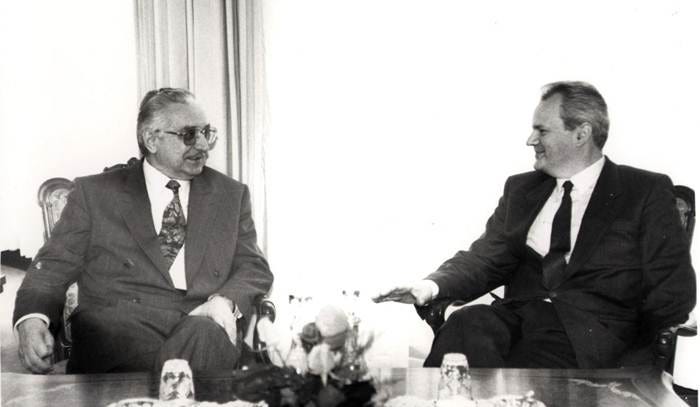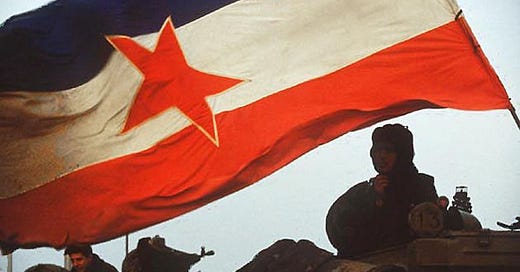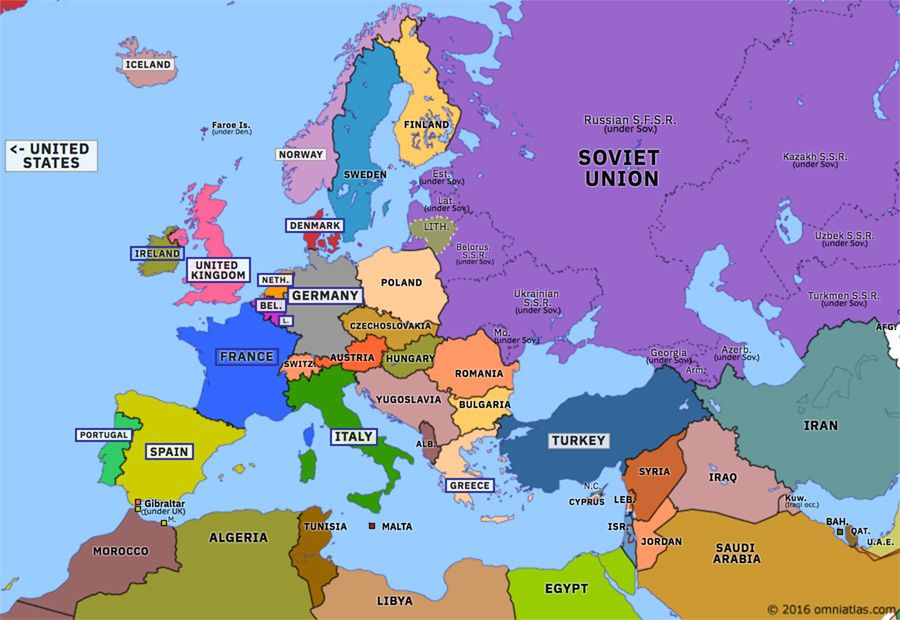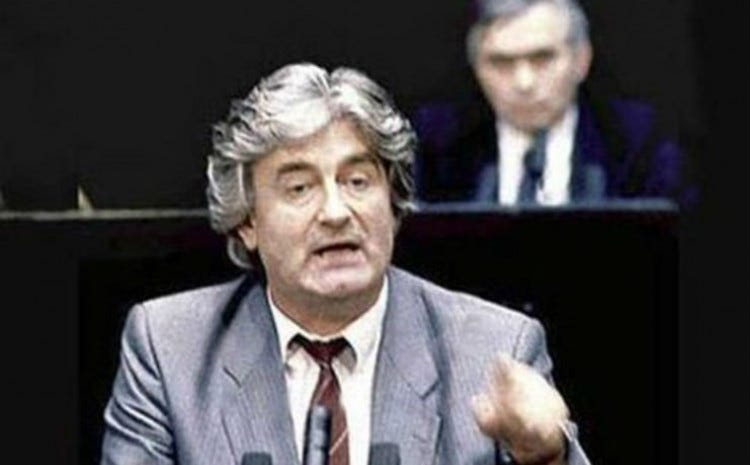S2E20. The Ghost of 1991 past, present and future
In the midst of Christmas atmosphere, a brief summary of the year that led to the dissolution of Yugoslavia, exactly 30 years ago. Month by month, the timeline of the events by BarBalkans - Podcast
Hi,
welcome back to BarBalkans, the newsletter with blurred boundaries.
For this last episode of 2021, I would like to sum up the year we have just spent together.
In a special way.
By now, you will know that we are taking a parallel path alongside the weekly BarBalkans newsletter, which follows the dissolution of Yugoslavia 30 years ago.
Month after month, the BarBalkans - Podcast time machine has been taking us back to 1991, the year that sealed the fate of European history.
In order to start 1992 (or rather 2022) together, all you have to do is a small donation. Every second Wednesday of the month you will receive an email, only for subscribers.
Today, I would like to analyze with you what happened this year.
1991.
In this newsletter you will find the link to each specific episode. The text content is reserved to subscribers, but here you can get an overview of the events, while on Spreaker and Spotify you can freely listen to all the podcasts.
Ethnic violence in Yugoslavia
In January, the book of the Yugoslav Wars has a precise subtitle: “Money”.
The economy of Yugoslavia is collapsing and the socialization of debt mechanism (a collective settlement of the financial shortfalls in every single Republic) is no longer sustainable. Slovenia and Croatia want a market economy.
It is also the month of “the heist of the century” in Slobodan Milošević’s Serbia: half of the issuing money planned for the whole 1991 in Yugoslavia is used for the presidential election campaign in the Socialist Republic of Serbia.
It may not seem like an unresolvable issue, but the dynamics of a ethnic war emerge in February.
In the Croatian regions of Krajina, Banija and Slavonia, the Serb minorities fears that Zagreb’s independence will cause the rupture of their ties with Belgrade.
This is why the Serbs draw up the Ram Plan, a secession plan supported by the Yugoslav People’s Army and the bloodthirsty paramilitaries.
In March, when the Yugoslav Wars are not officially started yet, we count the first victims of war near Titova Korenica. Also in Belgrade squares, dead bodies lie on the ground in the clashes caused by anti-government protests.
The atmosphere is made even more explosive by the passive attitude of the Western world.
Since April, European diplomatic services have been paralyzed by divisions on the interpretation of the events. The United States has been hoping for maintaining the status quo without any real effort.
In the meantime, the clashes in Croatia become increasingly more violent and the project of the Greater Serbia (all the territories inhabited by ethnic Serb population in a single nation) is becoming real.
While the referendum on independence from Yugoslavia is held in May, Croatian and Serbo-Croatian extremists clash in Borovo Selo (in Eastern Slavonia). The result of an ambush on the Croatian police is 15 deaths.
The time has come for war. But for real.
The first months of war in the Balkans
June is characterized by the word that will be repeated most often for the next 10 years: war.
On June 26, Slovenia declares its independence. The reaction of the Yugoslav People’s Army is harsh. The federal tanks appear on the border with Italy and Austria: the ten-day war has begun.
In the midst of armed clashes and bombings, the Western public opinion is convinced by the Slovenian propaganda that the Republic is the victim of an aggression.
As part of a 3-month moratorium on independence, a series of truces (almost always violated) are granted, leading to the Brioni Agreement on July 7.
Basically, Yugoslavia says goodbye to Slovenia, although not yet formally.
However, July is not the month that ends the war. Quite the opposite, in fact.
When Croatia also proclaims independence, a new war front opens up and it will last for years.
Comparing to Slovenia, the difference is the presence of an ethnic Serb minority in Croatia: Milošević declares that «where there is a Serbian grave, there is Serbia».
From the Adriatic to Vukovar, the way for ethnic cleansing is paved.
The Serbian advance in Croatia - led by the Yugoslav People’s Army and the Chetniks paramilitaries - is unstoppable. In August, President Franjo Tuđman’s defensive tactics proves disastrous.
On August 19, on the banks of the Danube, the siege of Vukovar (Vuk vár, the Wolf Fortress) begins.
The city is cosmopolitan and strategically located, but it is surrounded by a network of Serbo-Croatian villages.
Civilians have to secure themselves in bunkers and cellars for 90 days, while the defense rampart tries to resist the constant bombings, day after day.
Meanwhile, on September 7, the Peace Conference on Yugoslavia is opened in The Hague. It sets the ambitious goal of securing peace within two months.
In September, the Western world tries to mediate among the Socialist Republics. Starting with Macedonia, one after the another proclaims secession.
This is why, while Serbian military operations extend to Bosnia and Herzegovina, Belgrade welcomes happily the UN Resolution 713, which imposes a general and total embargo on all supplies of arms and war material in the Balkans.
In practice, it favors Serbia, which controls the federal Army and the war industry.
The war continues, with all the advantages on the Serbian side, reaching Zadar, Split and Dubrovnik on the Dalmatian coast.
In October, even the presidential palace in Zagreb is hit by two missiles, in a (failed) attempt at Tuđman’s life.
This is Milošević’s response to Croatian defiant attitude, on the day when the 3-month moratorium on Slovenian and Croatian independence sanctioned by the Brioni Agreement expires.
The situation in Vukovar is desperate: the city is without water and electricity, it is hit by over 5 thousand bullets a day and it relies only on supplies parachuted by Zagreb’s military planes.
In the meantime, the Republic of Kosovo is born and a referendum on independence is held in Sanjak (the historical region with Muslim majority). All this is illegal for Belgrade.
When similar decisions are taken in Bosnia, the situation gets desperate.
The Serbs of Bosnia’s leader, Radovan Karadžić, casts his curse on the future genocide: «Bosniaks will not be able to defend themselves if they wage war. They will perish on the highway to hell».
It is clear that Karadžić is serious. In November, his party claims to be the Parliament of the Serbian People in Bosnia and Herzegovina and a few weeks later it proclaims the birth of the Republika Srpska (obviously, he becomes the President).
However, as we were saying, after 90 days of siege Vukovar is the epicenter of the violence. On November 18, the Wolf Fortress falls, in a macabre scenario full of episodes of ethnic cleansing.
Despite the fact that Croatia risks total defeat, from Belgrade comes the order to stop the advance of the Yugoslav People’s Army. The goal of defending the areas populated by the Serb people has been achieved.
The European Community has failed in handling the crisis and hands over to the UN. Preparations begin for the intervention of the Blue Helmets.
At the beginning of December, the Vance Plan (elaborated by the Special Envoy for Croatia, Cyrus Vance) is ready. The Army will retreat to Serbia, the paramilitaries will have to surrender their weapons and three United Nations Protected Areas (UNPA) will be created in Krajina, Banija and Slavonia.
As a reaction, the leader of the Serbo-Croats, Milan Babić, proclaims the independence of the Republic of Serbian Krajina, following in the footsteps of the Serbs of Bosnia.
While the European Community is ready to officially recognize the sovereignty of Slovenia and Croatia and to open negotiations for the independence of all the other Republics, Bosnia is in the spotlight.
In an almost paradoxical situation - while they are facing off in a series of bloody war actions from Slavonia to Krajina - the Presidents of Serbia and Croatia meet secretly to draw up a plan to split up what they call «a fake entity».
Following the first meeting in Karađorđevo in March, they seek an agreement to draw the borders of Greater Serbia and Greater Croatia, with a Muslim buffer zone.
The eve of 1992 is anything but reassuring.

In mid-January, we will continue our parallel journey, following the events in Yugoslavia at war 30 years ago.
Pit stop. Sittin’ at the BarBalkans
We have reached the end of this piece of road.
Since we are in a spirit of reminiscence (also due to the Christmas atmosphere), BarBalkans offers us again two specialities to warm up this winter day.
On our bar we find a small glass of hot rakija, one of the most typical Balkan Christmas drinks, very easy to prepare.
And then there is a cup of kuhano vino, the Balkan mulled wine. The wine is boiled with a combination of nutmeg, cloves, cinnamon, sugar, orange juice and zest.
Let’s continue the BarBalkans journey. We will meet again in a week, for the 21st stop.
A big hug and have a good journey!
If you want to receive the monthly newsletter/podcast and help BarBalkans become an economically viable project, you can consider a small donation, as you wish:
If you know someone who might be interested in BarBalkans - Podcast, you can forward this email to them.
Or you can give a gift subscription. All you have to do is click on the link below, choose the option you prefer and to whom you want to give it:











